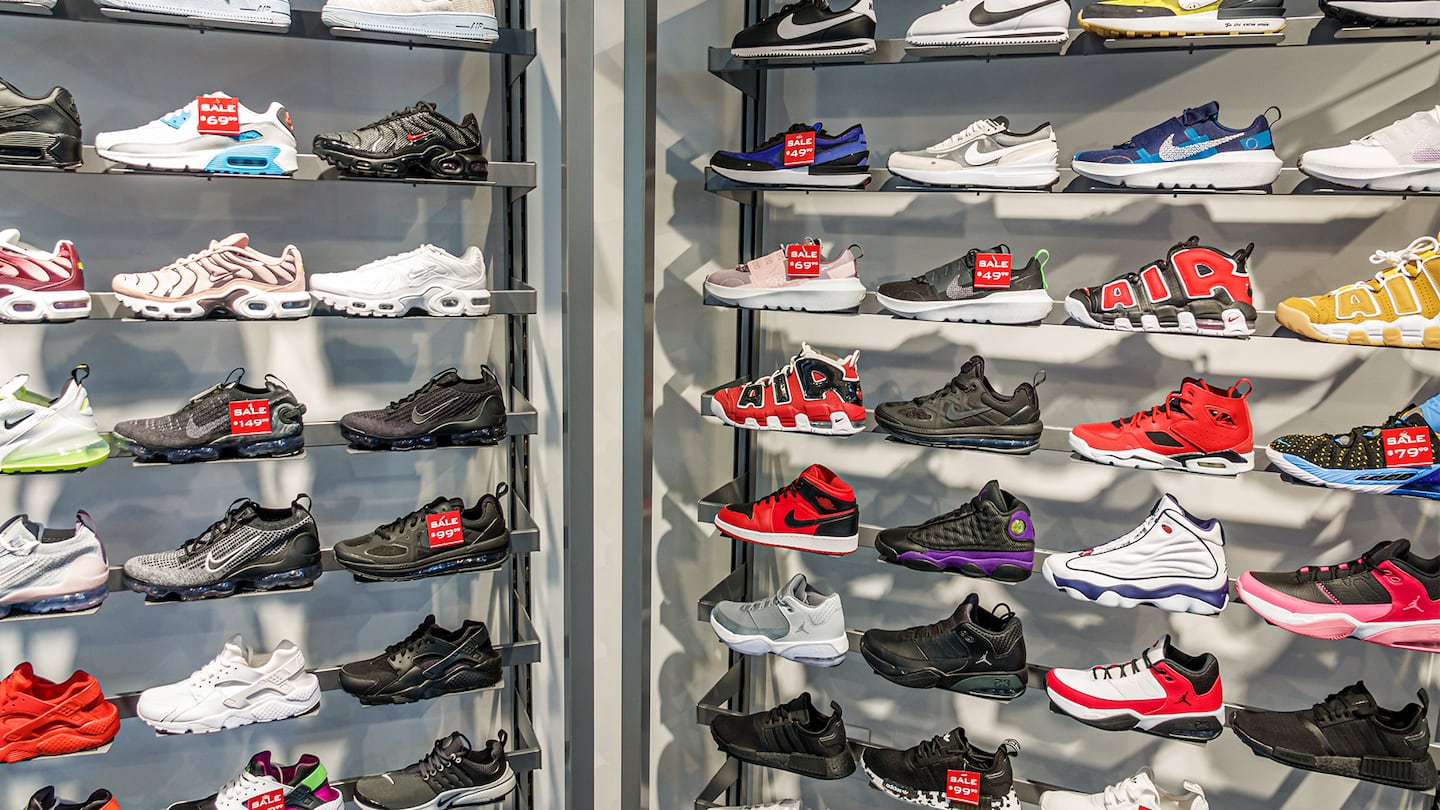Agenda-setting intelligence, analysis and advice for the global fashion community.
Last week, Dick’s Sporting Goods made a $2.4 billion bet on Foot Locker that will affect every major player in the sneaker industry.
With the acquisition, Dick’s is buying a sneaker-retailing leader with nearly $8 billion in annual sales, locations at malls across the US and a strong — if faded — presence in sneaker culture. While Foot Locker has run into challenges in recent years, having closed over 20 percent of its stores globally since 2019, suffered as Nike and Adidas prioritised sales through their own channels and lost customers to influential boutiques like Kith, it remains a prominent force.
Dick’s, meanwhile, has a thriving business in sporting goods with a network of successful brick-and-mortar locations and ambitions to be a bigger player in the sneaker world. Analysts believe the companies could better work with suppliers to ensure that all the footwear retailers under their umbrella, which would include Foot Locker subsidiaries such as Champs Sports, are not only operationally sound but also offer well-rounded assortments focused more on new and compelling products rather than discounted sneakers.
If they’re able to come together and create a new sneaker powerhouse, it could shift the industry landscape.
ADVERTISEMENT
“The hope is that if [Dick’s Sporting Goods] can replicate their success within the preeminent sneaker retailer in North America, you’ll create a better marketplace for the industry overall,” said Needham & Company analyst Tom Nikic.
But not every company in the wider sneaker world would be impacted equally. Retailers such as JD Sports, a UK chain in the midst of a US expansion, would face tough new competition, while some brands could lose shelf space at the expense of others. No brand may be watching more closely than Nike, which counts on both Dick’s and Foot Locker as important retail partners.
Maybe the biggest shift of all would be if Dick’s could help Foot Locker return to its former glory as a top destination for sneaker fans.
“I’d say 2019, 2018, was the last time I felt that Foot Locker was relevant to the culture in terms of like ‘I’m going to go there and get the new sneaker,’” said Nicholas Vlahos, a writer for the sneaker release news site Sole Retriever. “They still have good standing in the culture but it’s just not the first choice.”
The Sneaker Ecosystem
Joining forces should give the retailers greater reach and more leverage with brand partners. That combination poses a threat to direct rivals such as JD Sports, which reported a drop in first-quarter sales on Wednesday and warned that US president Donald Trump’s tariffs could dampen demand. The company, which owns the American sneaker retailers Finish Line, DTLR and Shoe Palace and acquired the US-based sporting goods retailer Hibbett in 2024, has emerged as a major competitor to Foot Locker in the US.
“JD Sports cater more to those in tune with what streetwear is now than what’s in the Foot Locker store in my mall down the road,” said Vlahos, who noted that his local Foot Locker only has general releases on sale rather than exciting new products. “JD’s always moving product and it’s always changing, whereas Foot Locker feels a little stale.”
Were Dick’s to successfully mount a resurgence of Foot Locker, or build a bigger following for itself among sneaker fans, JD Sports would feel the pressure. Analysts at UBS said in a May 15 research note that Dick’s purchase of Foot Locker “could pose further challenges for JD Sports in delivering sustainable outperformance in North America.”
It seems less likely that boutiques such as Kith or Concepts would see the same effects. Nikic said they serve a different role within the ecosystem, driving excitement and heat to the marketplace that trickles down to larger retailers. They’ll continue to serve as a marketing arm for sneaker brands and won’t likely have their limited-edition releases impacted by the acquisition.
ADVERTISEMENT
It’s why Whitaker Group founder James Whitner, who owns sneaker boutiques like A Ma Maniére and Social Status, isn’t worried.
“We need them to have the ability to scale, so our brand partners have the ability to leverage more resources to incubate new things with us,” said Whitner. “We’re here to drive culture, purpose, cool and experience.”
Brand Winners and Losers
Brands have their own stake in the future of Dick’s and Foot Locker. Nike stands to win or lose more than most, given that last year it accounted for 59 percent of the total merchandise Foot Locker bought. The deal gives Dick’s new incentive to see Nike execute a turnaround, because if it does, Foot Locker will disproportionately benefit.
“If Nike can get back to where it has been in the past demand-wise, then everybody will eat,” said Lois Sakany, director of retail at research firm BWG Global.
Dick’s and Foot Locker, however, will have more power to negotiate for Nike’s best products, and Dick’s could push Foot Locker toward a more rounded assortment, according to Nikic, leaving Nike to compete for floor space that might have been given to it in the past.
Adidas and Puma will face their own dynamics. In the short-term, Adidas probably won’t see much impact given its momentum, but in the long-term it could face more difficulty increasing its shelf space at Foot Locker given Dick’s strong relationships with a number of brands, the UBS analysts noted. Puma’s smaller size and current weakness in the US, meanwhile, mean it could be among those that lose space to others.
One brand that could see its assortment increase is Swiss running brand On. It has a strong relationship with Dick’s but a smaller business at Foot Locker. It believes the deal could help it expand its presence at the sneaker retailer and “unlock a younger male demographic in the US where it is underpenetrated relative to the balance of the globe,” according to a recent note from investment bank William Blair, whose analysts were meeting with On’s management the day the deal was announced.
Getting Foot Locker Back on its Feet
In order for Dick’s and Foot Locker to shake up the sneaker industry, they first need to stabilise Foot Locker, which has lost a step over the past several years. Vlahos, who estimates he’s collected over 100 pairs of sneakers since 2017, said he’s not moved to buy sneakers at Foot Locker today beyond discounted products due to a lack of exciting new releases, a poor online shopping experience and a lacklustre loyalty program.
ADVERTISEMENT
“If you look at JD Sports and Finish Line, their rewards program benefits customers so well that it incentivises you to stay purchasing with them,” said Vlahos.
Foot Locker has actively sought to remedy such paint points since unveiling its “Lace Up” turnaround strategy in 2023. Last year, after re-launching its “FLX Rewards” program and upgrading its mobile app experience, Foot Locker CEO Mary Dillon shared on an earnings call in March that Foot Locker saw “a meaningful step-up” in its sales capture rate and increased frequency of purchase amongst its customers.
Dick’s has a good deal to offer Foot Locker on these points. Sakany believes Dick’s is more technologically advanced and will improve Foot Locker’s online business while also strengthening its loyalty program, pointing out how Dick’s rewards program has been linked with Nike’s own for several years. Nikic adds that beyond helping Foot Locker build out a stronger loyalty program, what Dick’s brings to Foot Locker is a better multi-brand shopping experience for sneaker customers.
“Dick Sporting Goods has done a really good job elevating their in-store presentation of footwear within the last 5-10 years … It’s a very well thought-out experience for the customer,” said Nikic. “Whereas for Foot Locker, given that they used to be so heavily reliant on Nike and Nike Basketball, multi-brand and multi-category presentation to the consumer can use a little bit of work.”
Sakany believes Foot Locker being under Dick’s opens up opportunities that even go beyond sneakers, such as bringing apparel accounts with brands like Carhartt and even complementary product categories such as sports hydration into Foot Locker’s business.
What will be challenging is translating Dick’s acumen to Foot Locker, which serves a lower-income customer looking for stylish sneakers and apparel rather than sporting goods or performance-focused footwear. Sakany said Dick’s will need to walk a tightrope of not stepping on too many toes but not being too polite either and making sure real changes take place.
“These are the turbulent waters that Dick’s is choosing to enter,” she said.





